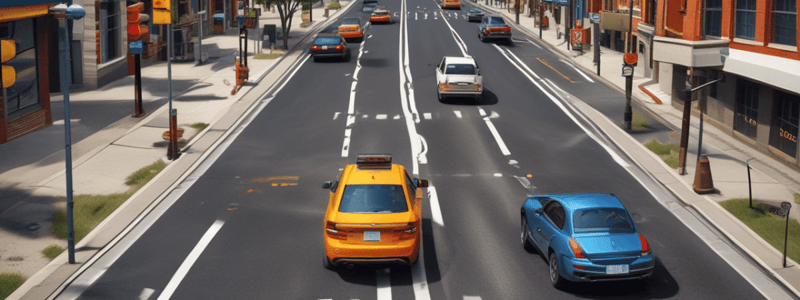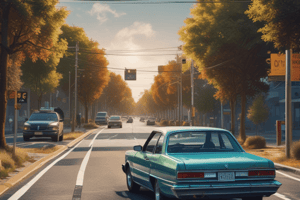Podcast
Questions and Answers
Where should you look before starting to move at a stopped intersection?
Where should you look before starting to move at a stopped intersection?
- Look behind you and then ahead
- Look to the left and right (correct)
- Ignore the surroundings if you have the right of way
- Only look in the direction you plan to turn
What should you ensure before crossing an intersection when stopped?
What should you ensure before crossing an intersection when stopped?
- Speed up to avoid getting stuck at the intersection
- Cross the intersection even if it means blocking it
- Immediately make your move to avoid wasting time
- Ensure there is space to cross completely (correct)
When turning left or right across oncoming traffic, what distance should you turn on your signal ahead?
When turning left or right across oncoming traffic, what distance should you turn on your signal ahead?
- 200 feet
- 50 feet
- At the intersection point
- Within 100 feet of the intersection (correct)
If you are on a street with a bicycle lane, what should you do before making a turn?
If you are on a street with a bicycle lane, what should you do before making a turn?
When may you turn right on red?
When may you turn right on red?
When approaching an intersection, even if other traffic has a red light or stop sign, what should you do?
When approaching an intersection, even if other traffic has a red light or stop sign, what should you do?
If your view of a cross street is blocked when stopped at an intersection, what should you do?
If your view of a cross street is blocked when stopped at an intersection, what should you do?
When approaching areas with a lot of activity along the side of the road, what is most important?
When approaching areas with a lot of activity along the side of the road, what is most important?
When approaching a railroad crossing, what should you do?
When approaching a railroad crossing, what should you do?
If you're unsure if it's safe to cross a railroad track, what should you do?
If you're unsure if it's safe to cross a railroad track, what should you do?
When should you never start to cross a railroad crossing?
When should you never start to cross a railroad crossing?
What should you do at crossings with more than one track?
What should you do at crossings with more than one track?
Why is it important to look behind you while driving?
Why is it important to look behind you while driving?
What should you do before changing lanes?
What should you do before changing lanes?
Why should you look over your shoulder when changing lanes?
Why should you look over your shoulder when changing lanes?
What is a key reason for checking for vehicles behind you when driving down a long or steep hill?
What is a key reason for checking for vehicles behind you when driving down a long or steep hill?
What action should you take if you need to change lanes, slow down, or back up?
What action should you take if you need to change lanes, slow down, or back up?
Flashcards are hidden until you start studying




